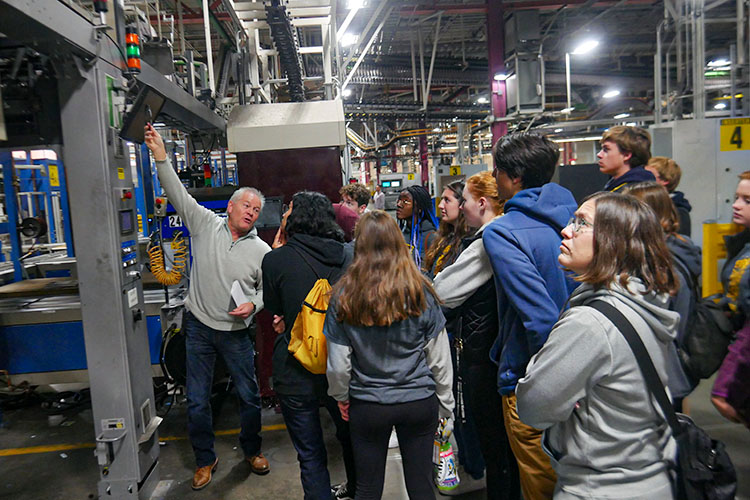
Taken by A.J
The TJ Journal newspaper staff visited The Denver Post printing press and newsroom to get a first hand look at what it’s like to run a professional paper.
On November 1st, the Newspaper Staff hopped on some buses and traveled to The Denver Post. Typically, the printing press and newsrooms are not open to the public, but The Denver Post made a special exception for the TJ news staff and gave them a thorough tour of the entire plant.
The tour began when Brian Lane, Production Director, led the class through the paper warehouse: the start of the printing process. It was a huge room filled to the brim with rolls of paper. Despite that, the amount of paper stored in the warehouse will only last for 33-45 days of print. Students were in awe at the sheer quantity and size of all the paper there. Laser Guided Vehicles (LGVs) are high tech sensory robots that then work like magic to move the rolls from the warehouse to the printing presses. One roll of paper in one printing press makes about 32,000 copies of a paper.
Back in 2001, over 235 employees used to man the printing presses at The Denver Post. Now though, only 35 employees work in the printing presses. The facility prints multiple other papers in addition to the Post. “If we had just The Denver Post printed here, we wouldn’t survive,” said Lane. Printing other papers in the facility was a strategic move because the company wanted to stay local instead of outsourcing. They print papers like USA Today, the Wall Street Journal, and the New York Times. By printing these other papers, it allows The Denver Post to maintain the facility and pay their workers all while remaining local. Lane commented: “We always have to be adapting. We have to do whatever it takes, and that is always changing too.”
After the papers are printed, they travel along conveyor belts on the ceiling into the mailroom. Here, the TJ newspaper staff was joined by Senior Professional Director Hal Mortensen. He explained that the mailroom is where papers are organized, packaged, and shipped off to their respective destinations. Over 60 million papers a month go through the mailroom which operates 24/7. The papers are also printed 24 hours in advance in order to leave enough time for delivery. There are two types of deliveries: the daily paper deliveries and the Sunday paper deliveries. The packaged newspapers make their way to over 17 distribution centers that transport papers to their destinations anywhere from Sterling, Colorado, to Moab, Utah. TJ Journal Editor and junior Ava Ward commented: “It was fascinating to learn how thousands of newspapers are printed and delivered in such a small amount of time.”
The TJ newspaper staff was then extremely privileged to be permitted to sit in on an authentic Denver Post editor meeting. Here, all the editors and head editor Lee Ann Colacioppo gathered to reflect on the previous day and discuss their goals for the present one. The meeting helped update everyone and make sure articles and photos are all ready to be printed. They also discussed managing upcoming articles, who should tackle what topics, breaking news, and each editor’s goals. Collaboration and flexibility were prevalent as the team debated what warranted front page coverage. “I was inspired by the staff’s devotion to producing accurate and interesting news,” said Ward.
This trip was especially relevant because of the current struggles newspapers and journalists face in this decade. Senior and TJ Journal Editor-in-Chief, Mia Carpenter, said: “It was a good opportunity from a generational point of view because society has somewhat lost the appreciation for physical print. Having us as teenagers, who grew up in an era where newspapers aren’t as common as online news, visit the plant was interesting because we got to see the physical work that goes into newspaper production.” The Denver Post has been a Colorado staple since 1892 and a powerful source of information for all readers. Papers like The Denver Post are extremely important in maintaining public trust by reporting accurately on topics that matter to the local people they serve. The paper cares deeply about honesty and the power information being in the hands of the public. “Credibility is our most important thing; if we don’t have that no one will trust us,” explained Colacioppo. Despite this, the paper is still struggling. People are more often getting their news from online sources of media than from a printed paper. The Denver Post has an online version of their paper published every day just like their printed one in order to cater to current trends. Substantial journalism drives their subscriptions which is why The Denver Post is dedicated to honest and important journalism rather than fluffy “clickbait” articles that flood the internet. Newspapers like The Denver Post are essential to educating the public and deserve more support than they’re currently receiving. “Some people say newspapers are dying… Only if we let them,” said Mortensen.
You can support The Denver Post by visiting their website, subscribing to their paper, or joining their online membership.